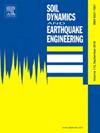Response spectrum method for seismic analysis of aboveground structure based on effective frequencies and modes of soil-structure interaction system
IF 4.2
2区 工程技术
Q1 ENGINEERING, GEOLOGICAL
引用次数: 0
Abstract
Response spectrum method (RSM) is one of the practical methods for seismic analysis and design of aboveground structures, which has been widely used in engineering design. Modal analysis is the most fundamental and time-consuming step of the RSM, and its direct application to three-dimensional (3D) soil-structure interaction (SSI) system will result in low efficiency of the RSM because the modal analysis results contain a large number of useless soil modes. To address these challenges, an efficient method for calculating the effective frequencies and modes that control the seismic response of the structure in 3D SSI systems is firstly developed based on iterative static analysis. This method can directly obtain the effective frequencies and modes and avoid the modal analysis of the whole SSI system. Subsequently, the influence of different site shear wave velocity and the presence of adjacent underground structures with different cross-sections on the effective frequencies of aboveground structures are investigated by the developed method. Finally, an RSM based on effective frequencies and modes considering the SSI is developed for seismic response analysis of 3D aboveground structures. Examples are provided to demonstrate the effectiveness of the RSM in the seismic analysis of complex aboveground structures.
基于土-结构相互作用体系有效频率和振型的地上结构地震反应谱分析方法
反应谱法是一种实用的地上结构抗震分析与设计方法,在工程设计中得到了广泛的应用。模态分析是模态分析中最基础、最耗时的步骤,将模态分析直接应用于三维土-结构相互作用体系,由于模态分析结果中含有大量无用的土模态,导致模态分析效率低下。为了解决这些挑战,首先基于迭代静力分析开发了一种有效的方法来计算控制三维SSI体系结构地震反应的有效频率和模态。该方法可以直接得到有效频率和振型,避免了对整个SSI系统进行模态分析。随后,利用该方法研究了不同场地横波速度和相邻不同截面地下结构的存在对地上结构有效频率的影响。最后,建立了基于有效频率和振型的考虑SSI的地面三维结构地震响应分析方法。算例验证了RSM在复杂地上结构地震分析中的有效性。
本文章由计算机程序翻译,如有差异,请以英文原文为准。
求助全文
约1分钟内获得全文
求助全文
来源期刊

Soil Dynamics and Earthquake Engineering
工程技术-地球科学综合
CiteScore
7.50
自引率
15.00%
发文量
446
审稿时长
8 months
期刊介绍:
The journal aims to encourage and enhance the role of mechanics and other disciplines as they relate to earthquake engineering by providing opportunities for the publication of the work of applied mathematicians, engineers and other applied scientists involved in solving problems closely related to the field of earthquake engineering and geotechnical earthquake engineering.
Emphasis is placed on new concepts and techniques, but case histories will also be published if they enhance the presentation and understanding of new technical concepts.
 求助内容:
求助内容: 应助结果提醒方式:
应助结果提醒方式:


